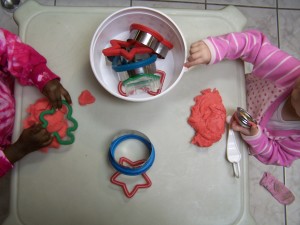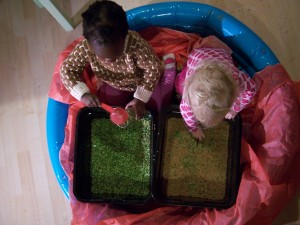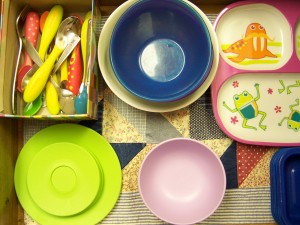By Rita Brhel, API’s publications coordinator, managing editor of Attached Family magazine and an API Leader (Hastings, Nebraska, USA).

It’s amazing how far our understanding of children has come in the last two decades since 1994, when Barbara Nicholson and Lysa Parker cofounded Attachment Parenting International (API). I was in middle school at that time, dutifully sitting in a desk all day and using rote memory to absorb classroom material as was expected. Two years later, my sister did the same.
But in another four years, my brother entered the same classroom. A brilliant but easily bored child, he was not content to sit in a desk all day, and he learned best by moving—a lot! Unfortunately the public school he was attending was not at all equipped to accommodate his learning style, and my brother struggled through to graduation. Life has done little to hold him back, though, and today he is a highly successful young man.
API doesn’t take a stance on educational choices, but whether we as parents decide to homeschool, unschool or enroll our children in a public, private or charter program, API supports making informed choices throughout the parenting journey, and that includes our child’s learning environment. One of my favorite people to discuss this topic with is Carolina Blatt-Gross, PhD, an Assistant Professor of Art at Georgia Gwinnett College in Lawrenceville, Georgia, USA, who lectures on art education. She is the mother of two very active children and a proponent of progressive learning environments.
RITA: Thank you, Carolina, for fitting me into your busy schedule. To begin, can you share about your passion for encouraging progressive learning environments for children?
DR. BLATT-GROSS: I have been making art as long as I can remember, but it wasn’t until I earned my PhD in art education that I realized how important art is to our educational environments and how quickly the arts are disappearing from traditional education.
We have become so focused on the linear, positivist thinking measured by standardized tests that we have forgotten about encouraging our brains to think in diverse, critical and creative ways. Art is essentially an elaborate problem-solving exercise situated in the enormously satisfying experience of making something with your hands and/or body—which means if you learn kinetically, the arts offer a wealth of opportunities to physically grapple with ideas and communicate nuanced concepts.
Once I had children, my dedication to art education was no longer academic. It became imperative that my sons have consistent opportunities to make things and to solve complex visual problems.
RITA: Your CNN article, “Why Do We Make Students Sit Still in Class?” very much piqued my interest as many of Attachment Parenting families have children with “spirited” temperaments, including children who do not fit well in the traditional mold of sitting at a desk all day. What learning environments are better for enhancing learning for any child, whether spirited or not?
DR. BLATT-GROSS: What learning environment is best depends on the temperament of each child. Some children might flourish in a still, silent classroom. Those children might find movement and sound distracting.
Other children, like mine, require a more active environment that will allow them to filter learning through their bodies. For these children, focusing their energy on restraining their bodies is a waste of student and teacher resources. This does not mean that they should be permitted to run around the classroom screaming and flailing chaotically, but rather that their bodies should become part of the learning in a structured way.
RITA: You mention your sons in the CNN article. How old are they now and what learning environment do you have them in?
DR. BLATT-GROSS: My sons are now 18 months old and 3 years old. My youngest son stays with a caretaker in our neighborhood who is invested in including music and art-making in his day.
My older son attends Hess Academy, which is a progressive school in Decatur, Georgia [USA], dedicated to authentic and child-focused learning. The teachers are exceptional at identifying and supporting students’ physical, intellectual, emotional and developmental needs. The students get to regularly experience art, music, language, yoga, dramatic storytelling, outdoor classrooms and all kinds of wonderful kinetic learning.
Although traditional formal education often dismisses these hands-on activities as secondary to the educational “meat and potatoes”—math and literacy—the teachers at my son’s school recognize that physical learning is part of the main course. Their bodies actually become part of their learning environment rather than a detriment to it.
RITA: How is this trend of pro-movement learning environments progressing among formal public/private schools? Are these progressive learning environments more the exception to the rule or are more schools beginning to go this route?
DR. BLATT-GROSS: Education seems to be heading in a more progressive direction, and it is easier to find teachers who are interested in alternatives to neatly aligned rows of silent students. Montessori schools have been taking this approach since 1907, but the quality can vary dramatically from school to school.
Fortunately, as we understand more about the brain and its mysteries, we are starting to translate some of the research into practice. We now know that different parts of the brain are active during different activities, so the more parts of the brain we can activate during learning, the richer the experience will be for students—and the more profound their understanding of a concept. For example, learning to speak a letter, write a letter, read a letter, make that letter with your body, sing about that letter, paint a picture of that letter and so on all require different, but related, skills. These concepts build upon one another to create a more profound understanding.
RITA: I live in a rural, conservative-minded area and yet hear of some teachers in the area experimenting with having children sit on bouncy balls rather than chairs. Are there some ideas that are catching on more than others?
DR. BLATT-GROSS: Bouncy balls and rocking chairs as well as some sensory tools are becoming more common in classrooms and often with very positive results.
While there are likely benefits to allowing more movement in the classroom for some students, I would be wary of a one-size-fits-all approach, where all students sit on balls, simply because some are wiggly. This also seems like a palliative approach to a deeper problem. The bouncy balls might appease some students’ physical natures, but it doesn’t make that movement a meaningful part of the learning. It seems to be an easy fix but not a true embrace of the potential learning that could happen through students’ bodies.
RITA: Many public schools, in an effort to balance budgets with limited state funding as well as meet testing standards, are reducing time in schools in art, music and physical education classes as well as recess. What are your thoughts?
DR. BLATT-GROSS: There is plenty of research on the cognitive benefits of the arts. Studio Thinking (Hetland and Winner, et al.) and Arts and the Creation of Mind (Elliott Eisner) are two well-written sources. Unfortunately, in our test-centric culture, we often expect the arts to play a supporting role to subjects that are featured on standardized tests, and many studies attempt to understand how the arts can improve test scores.
However, the arts are worthwhile, satisfying and require complex thinking independent of their ability—or inability—to make us better at standardized tests. But that is more difficult to quantify.
Unfortunately, we tend to have a very narrow definition of intelligence that is generally limited to math and literacy skills, when in reality there are a multitude of different forms of thinking, communicating and problem solving. Forgetting about intellectual diversity is a myopic mistake, in my opinion. It not only alienates a large number of students but also creates a population with a limited, inflexible skill set and reduced intellectual resources.
Neglecting our bodies is never a good thing, either, both from a learning and fitness perspective.
RITA: What can parents do to advocate for more progressive learning environments in their local schools?
DR. BLATT-GROSS: Parents can be vocal advocates for progressive education. Simply letting the administration know when a teacher is trying something that is successful with your child can provide powerful evidence that something is working. The bigger challenge is conveying that information to the governing bodies in education, since they typically establish the standards and testing requirements that teachers find so limiting.
RITA: Thank you, Carolina, for your insights. A final question: For parents who homeschool, what are some tips to setting up a home-based learning environment?
DR. BLATT-GROSS: Parents who homeschool face the challenge of not having a whole team of educators with diverse skills, experiences and strengths to interact with their child. Take advantage of programs offered by local museum and cultural venues to get them exposed to topics and teaching styles that you may be unfamiliar with, particularly if your child does not share your learning style—which tends to be the natural basis for our teaching style. Also be sensitive and adaptable to your child’s strengths and weaknesses. If your student can’t focus on math because he wants to be outside all day, maybe it’s time to take the math lesson outside and start counting leaves.



 It’s that time of the week that everyone looks forward to: family game night. Here are some tips to make it go smoother and fun for everyone, including Mom:
It’s that time of the week that everyone looks forward to: family game night. Here are some tips to make it go smoother and fun for everyone, including Mom: The hours of 4 p.m. to 6 p.m., known in the restaurant and lounge world as “Happy Hour,” have not been historically happy in my house. A more accurate term would be the “Wicked Hours.” The reason for this is that two essential
The hours of 4 p.m. to 6 p.m., known in the restaurant and lounge world as “Happy Hour,” have not been historically happy in my house. A more accurate term would be the “Wicked Hours.” The reason for this is that two essential 
